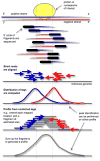ChIP-seq: advantages and challenges of a maturing technology
- PMID: 19736561
- PMCID: PMC3191340
- DOI: 10.1038/nrg2641
ChIP-seq: advantages and challenges of a maturing technology
Abstract
Chromatin immunoprecipitation followed by sequencing (ChIP-seq) is a technique for genome-wide profiling of DNA-binding proteins, histone modifications or nucleosomes. Owing to the tremendous progress in next-generation sequencing technology, ChIP-seq offers higher resolution, less noise and greater coverage than its array-based predecessor ChIP-chip. With the decreasing cost of sequencing, ChIP-seq has become an indispensable tool for studying gene regulation and epigenetic mechanisms. In this Review, I describe the benefits and challenges in harnessing this technique with an emphasis on issues related to experimental design and data analysis. ChIP-seq experiments generate large quantities of data, and effective computational analysis will be crucial for uncovering biological mechanisms.
Figures





References
-
- Henikoff S. Nucleosome destabilization in the epigenetic regulation of gene expression. Nat Rev Genet. 2008;9(1):15–26. - PubMed
-
- Li B, et al. The role of chromatin during transcription. Cell. 2007;128(4):707–19. - PubMed
-
- Allis CD, et al., editors. Epigenetics. Cold Spring Harbor Laboratory Press; Cold Spring Harbor, New York: 2007.
Publication types
MeSH terms
Substances
Grants and funding
LinkOut - more resources
Full Text Sources
Other Literature Sources

